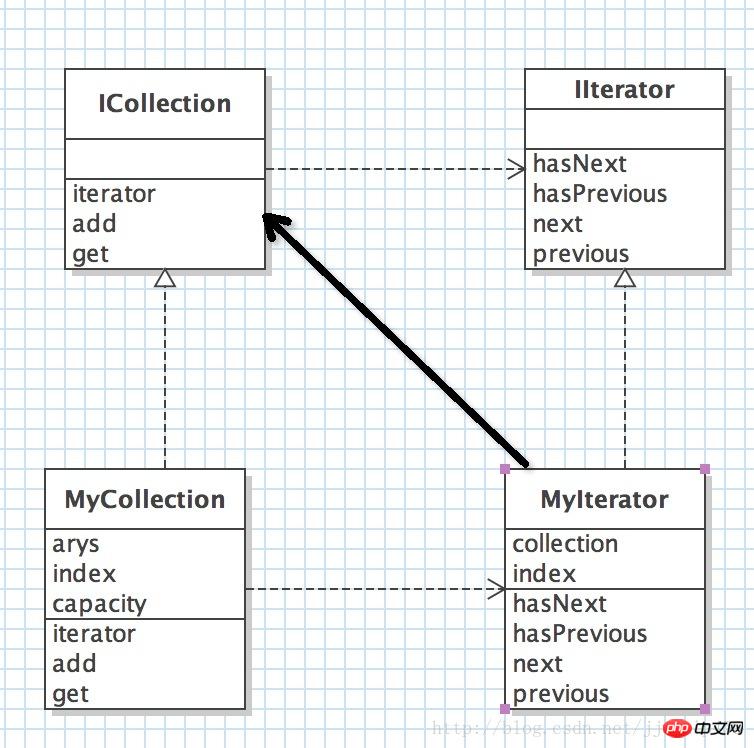
Class diagram

##
/**
* 自定义集合接口, 类似java.util.Collection
* 用于数据存储
* @author stone
*
*/
public interface ICollection<T> {
IIterator<T> iterator(); //返回迭代器
void add(T t);
T get(int index);
}/**
* 自定义迭代器接口 类似于java.util.Iterator
* 用于遍历集合类ICollection的数据
* @author stone
*
*/
public interface IIterator<T> {
boolean hasNext();
boolean hasPrevious();
T next();
T previous();
}/**
* 集合类, 依赖于MyIterator
* @author stone
*/
public class MyCollection<T> implements ICollection<T> {
private T[] arys;
private int index = -1;
private int capacity = 5;
public MyCollection() {
this.arys = (T[]) new Object[capacity];
}
@Override
public IIterator<T> iterator() {
return new MyIterator<T>(this);
}
@Override
public void add(T t) {
index++;
if (index == capacity) {
capacity *= 2;
this.arys = Arrays.copyOf(arys, capacity);
}
this.arys[index] = t;
}
@Override
public T get(int index) {
return this.arys[index];
}
}/*
* 迭代器(Iterator)模式 又叫做游标(Cursor)模式
* 提供一种方法访问一个容器(container)对象中各个元素,而又不需暴露该对象的内部细节。
* Iterator模式就是分离了集合对象的遍历行为,抽象出一个迭代器类来负责,这样既可以做到不暴露集合的内部结构,又可让外部代码透明的访问集合内部的数据
*
* 若有新的存储结构,可new 一个ICollection, 对应的 new 一个IIterator来实现它的遍历
*/
@SuppressWarnings({"rawtypes", "unchecked"})
public class Test {
public static void main(String[] args) {
ICollection<Integer> collection = new MyCollection<Integer>();
add(collection, 3, 5, 8, 12, 3, 3, 5);
for (IIterator<Integer> iterator = collection.iterator(); iterator.hasNext();) {
System.out.println(iterator.next());
}
System.out.println("-------------");
ICollection collection2 = new MyCollection();
add(collection2, "a", "b", "c", 3, 8, 12, 3, 5);
for (IIterator iterator = collection2.iterator(); iterator.hasNext();) {
System.out.println(iterator.next());
}
}
static <T> void add(ICollection<T> c, T ...a) {
for (T i : a) {
c.add(i);
}
}
}3 5 8 12 3 3 5 ------------- a b c 3 8 12 3 5
The above is the detailed content of Code example of how to implement the Iterator pattern in Java. For more information, please follow other related articles on the PHP Chinese website!




